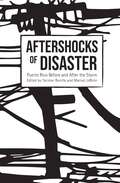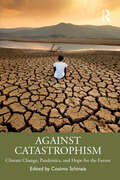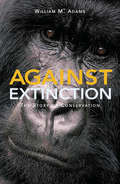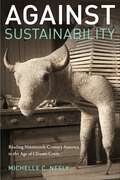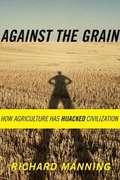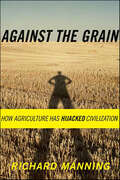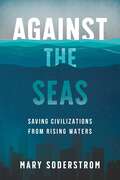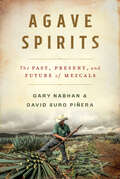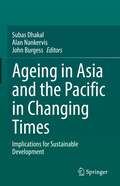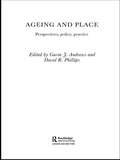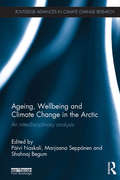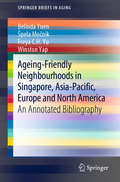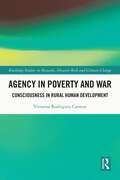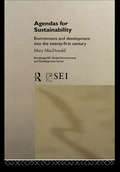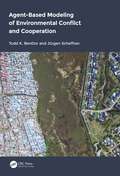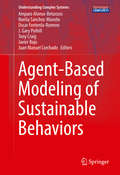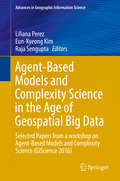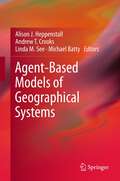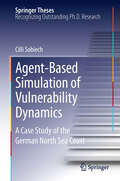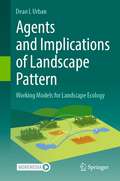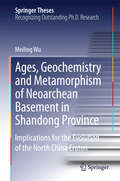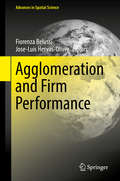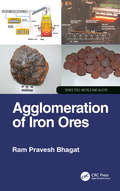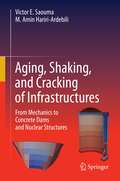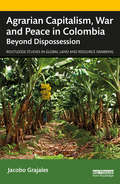- Table View
- List View
Aftershocks Of Disaster: Puerto Rico Before And After The Storm
by Yarimar Bonilla Marisol LeBronTwo years after Hurricane Maria hit, Puerto Ricans are still reeling from its effects and aftereffects. Aftershocks collects poems, essays and photos from survivors of Hurricane Maria detailing their determination to persevere. The concept of "aftershocks" is used in the context of earthquakes to describe the jolts felt after the initial quake, but no disaster is a singular event. Aftershocks of Disaster examines the lasting effects of hurricane Maria, not just the effects of the wind or the rain, but delving into what followed: state failure, social abandonment, capitalization on human misery, and the collective trauma produced by the botched response.
Against Catastrophism: Climate Change, Pandemics, and Hope for the Future
by Cosimo SchinaiaAgainst Catastrophism explores catastrophism from multiple vantage points and considers the impact of ongoing crisis on individuals.Bringing together contributors from psychoanalysis, economics, anthropology, and gastroenterology, this book explores themes including fossil fuel culture, social movements like Extinction Rebellion, the COVID-19 pandemic, media messaging, and the future of food supply chains. By assessing the value of a constant barrage of information about catastrophes and considering the need for a containing environment, the chapters explore how we can avoid endorsing a closed-off vision of the future and instead unlock possibilities. The book concludes with a discussion of optimism, radical hope, and how we can put forward a new narrative on nature.Against Catastrophism will be of great interest to psychoanalysts, psychologists, psychiatrists, economists, anthropologists, sociologists, food scientists, environmentalists, ecologists, politicians, and communication experts.
Against Extinction: The Story of Conservation
by William Bill Adams'Conservation in the 21st century needs to be different and this book is a good indicator of why.' Bulletin of British Ecological Society Against Extinction tells the history of wildlife conservation from its roots in the 19th century, through the foundation of the Society for the Preservation of the Wild Fauna of the Empire in London in 1903 to the huge and diverse international movement of the present day. It vividly portrays conservation's legacy of big game hunting, the battles for the establishment of national parks, the global importance of species conservation and debates over the sustainable use of and trade in wildlife. Bill Adams addresses the big questions and ideas that have driven conservation for the last 100 years: How can the diversity of life be maintained as human demands on the Earth expand seemingly without limit? How can preservation be reconciled with human rights and the development needs of the poor? Is conservation something that can be imposed by a knowledgeable elite, or is it something that should emerge naturally from people's free choices? These have never been easy questions, and they are as important in the 21st century as at any time in the past. The author takes us on a lively historical journey in search of the answers.
Against Sustainability: Reading Nineteenth-Century America in the Age of Climate Crisis
by Michelle NeelyAgainst Sustainability responds to the twenty-first-century environmental crisis by unearthing the nineteenth-century U.S. literary, cultural, and scientific contexts that gave rise to sustainability, recycling, and preservation. Through novel pairings of antebellum and contemporary writers including Walt Whitman and Lucille Clifton, George Catlin and Louise Erdrich, and Herman Melville and A. S. Byatt, the book demonstrates that some of our most vaunted strategies to address ecological crisis in fact perpetuate environmental degradation.Yet Michelle C. Neely also reveals that the nineteenth century offers useful and generative environmentalisms, if only we know where and how to find them. Henry David Thoreau and Emily Dickinson experimented with models of joyful, anti-consumerist frugality. Hannah Crafts and Harriet Wilson devised forms of radical pet-keeping that model more just ways of living with others. Ultimately, the book explores forms of utopianism that might more reliably guide mainstream environmental culture toward transformative forms of ecological and social justice. Through new readings of familiar texts, Against Sustainability demonstrates how nineteenth-century U.S. literature can help us rethink our environmental paradigms in order to imagine more just and environmentally sound futures.
Against the Grain: How Agriculture Has Hijacked Civilization
by Richard ManningIn this bold book, Richard Manning narrates a fascinating revisionist history of agriculture, from the domestication of plants and animals ten thousand years ago to today's corporate megafarms. Instead of a bucolic Ur-myth, Manning portrays an enterprise that was from its inception expansionist, and that did not so much accompany colonialism as drive it. Drawing on the work of anthropologists, biologists, archaeologists, and historians, as well as on his own extensive research, he traces a commodification of grain that has reached its apex in contemporary agribusiness and that has helped to build some of the most familiar -- and dysfunctional -- features of our political and economic landscape.
Against the Grain: How Agriculture Has Hijacked Civilization
by Richard ManningIn this provocative, wide-ranging book, Against the Grain, Richard Manning offers a dramatically revisionist view of recent human evolution, beginning with the vast increase in brain size that set us apart from our primate relatives and brought an accompanying increase in our need for nourishment. For 290,000 years, we managed to meet that need as hunter-gatherers, a state in which Manning believes we were at our most human: at our smartest, strongest, most sensually alive. But our reliance on food made a secure supply deeply attractive, and eventually we embarked upon the agricultural experiment that has been the history of our past 10,000 years.The evolutionary road is littered with failed experiments, however, and Manning suggests that agriculture as we have practiced it runs against both our grain and nature's. Drawing on the work of anthropologists, biologists, archaeologists, and philosophers, along with his own travels, he argues that not only our ecological ills-overpopulation, erosion, pollution-but our social and emotional malaise are rooted in the devil's bargain we made in our not-so-distant past. And he offers personal, achievable ways we might re-contour the path we have taken to resurrect what is most sustainable and sustaining in our own nature and the planet's.
Against the Seas: Saving Civilizations from Rising Waters
by Mary SoderstromAn incredible read.… While unflinching in her analysis, Soderstrom nevertheless gifts us with a message of hope and resilience. — MAUDE BARLOW, activist and author of Still Hopeful: Lessons from a Lifetime of Activism. What can we learn about coping with rising sea levels from ancient times?The scenario we are facing is scary: within a few decades, sea levels around the world may well rise by a metre or more as glaciers and ice caps melt due to climate change. Large parts of our coastal cities will be flooded, the basic outline of our world will be changed, and torrential rains will present their own challenges. But this is not the first time that people have had to cope with threatening waters, because sea levels have been rising for thousands of years, ever since the end of the last Ice Age. Stories told by the Indigenous people in Australia and on the Pacific coast of North America, and those found in the Bible and the Epic of Gilgamesh, as well as Roman and Chinese histories all bear witness to just how traumatic these experiences were. The responses to these challenges varied: people adapted by building dikes, canals, and seawalls; by resorting to prayer or magic; and, very often, by moving out of the way of the rushing waters. Against the Seas explores these stories as well as the various measures being taken today to combat rising waters, focusing on five regions: Indonesia, Shanghai, the Sundarbans of Bangladesh, the Salish Sea, and the estuary of the St. Lawrence River. What happened in the past and what is being tried today may help us in the future and, if nothing else, give us hope that we will survive.
Agave Spirits: The Past, Present, And Future Of Mezcals
by Gary Paul Nabhan David Suro Piñera“A manifesto…[and] a positive spin on the future of mezcal.” —Florence Fabricant, New York Times The agave plant was never destined to become tasteless, cheap tequila. All tequilas are mezcals; all mezcals are made from agaves; and every bottle of mezcal is the remarkable result of collaborations among agave entrepreneurs, botanists, distillers, beverage distributors, bartenders, and more. How these groups come together in this “spirits world” is the subject of this fascinating new book by the acclaimed ethnobotanist Gary Paul Nabhan and the pioneering restauranteur David Suro Piñera. Join them as they delight in the diversity of the distillate agave spirits, as they endeavor to track down the more distant kin in the family of agaves, and as, along the way, they reveal the stunning innovations that have been transforming the industry around tequilas and mezcals in recent decades. The result of the authors’ fieldwork and on-the-ground interviews with mezcaleros in eight Mexican states, Agave Spirits shows how traditional methods of mezcal production are inspiring a new generation of individuals, including women, both in and beyond the industry. And as they reach back into a rich, centuries-long history, Nabhan and Suro Piñera make clear that understanding the story behind a bottle of mezcal, more than any other drink, will not only reveal what lies ahead for the tradition—including its ability to adapt in the face of the climate crisis—but will also enrich the drinking experience for readers. Essential reading for mezcal connoisseurs and amateurs interested in unlocking the past of a delightful distillate, Agave Spirits tells the tale of the most flavorful and memorable spirits humankind has ever sipped and savored. Featuring twelve illustrations by René Alejandro Hernández Tapia and indices that list common and scientific names for agave species, as well as the names of plants, animals, and domesticated agaves used in the production of distillates.
Ageing Asia and the Pacific in Changing Times: Implications for Sustainable Development
by John Burgess Subas Dhakal Alan NankervisThis book demonstrates that there are wide-ranging potential challenges in addressing issues associated with ageing populations in both developed and developing countries of the region. This book brings together local, national and regional perspectives on the ageing population and sustainable development nexus in selected countries in the Asia Pacific region. The countries selected in this book include a mix of developed and developing economies that all reflect strong trade, investment and migration linkages. While the Asia Pacific region is forecast to enjoy high growth in the coming decade, a recurring common policy challenge is addressing the ‘demographic time bomb’ posed by ageing populations and workforces (Montague et al., 2017). Consequently, this book focuses on strategic policies and practices of multiple stakeholders, primarily: governments, industry and education systems, together with, the range of aged care services providers – in more effectively addressing these key socio-economic challenges associated with the ageing population for sustainable development.
Ageing and Place (Routledge Studies in Human Geography)
by David R. Phillips Gavin J. AndrewsDuring recent years, an increasing amount of academic research has focused on older people with a particular emphasis on settings, places and spaces. This book provides a comprehensive review of research and the policy area of 'ageing and place'. An insightful book on an important topic, Andrews and Phillips have together edited a valuable information and reference source for those with interests in the spatial dimensions of ageing in the twenty-first century. Ranging from macro-scale perspectives on the distribution of older populations on national scales, to the meaning of specific local places and settings to older individuals, on the micro-scale, the book spans an entire range of research traditions and international perspectives.
Ageing, Wellbeing and Climate Change in the Arctic: An interdisciplinary analysis (Routledge Advances in Climate Change Research)
by Shahnaj Begum Marjaana Seppänen Paivi NaskaliThe Arctic and its unique natural resources have become objects of increasing concern. Rapid climate change and ageing of the population are transforming the living conditions in the region. This translates into an urgent need for information that will contribute to a better understanding of these issues. Ageing, Wellbeing and Climate Change in the Arctic addresses the important intersection of ageing, wellbeing and climate change in the Arctic region, making a key interdisciplinary contribution to an area of research on which little has been written, and limited sources of information are currently available. The book explores three key areas of discussion. First, various political issues that are currently affecting the Arctic, such as the social categorisation of elderly people. Second, the living conditions of the elderly in relation to Arctic climate change. Third, the wellbeing of elderly people in terms of traditional knowledge and lifestyles. The book also features contributions from a number of key researchers in the field which examine a broad range of case studies, including the impact of climate change on health in Lapland and elderly people and geographical mobility in Norway. This book will be of great interest to scholars of climate change, gerontology and social policy.
Ageing-Friendly Neighbourhoods in Singapore, Asia-Pacific, Europe and North America: An Annotated Bibliography (SpringerBriefs in Aging)
by Belinda Yuen Špela Močnik Winston Yap Freya C.H. YuThis book brings together the emerging body of work on age-friendly neighbourhoods in Singapore, the Asia-Pacific region, Europe and North America. It begins with an overview chapter on the current state of policy, practice and research on age-friendly neighbourhoods in Singapore. This is followed by an annotated bibliography of published materials on age-friendly neighbourhoods in the above-mentioned countries and regions, encompassing theoretical work and empirical research reported on in journal articles, books and conference proceedings. The annotations for Singapore also map the grey literature, including unpublished dissertations and theses. The aim is to provide a sense of the scope of, issues in, and discourse on age-friendly neighbourhoods, the development of which is increasingly being recognised as a key strategy to support healthy ageing and enhance quality of life in ageing societies.
Agency in Poverty and War: Consciousness in Rural Human Development (Routledge Studies in Hazards, Disaster Risk and Climate Change)
by Vivianna Rodriguez CarreonThis book examines how people's self-awareness is affected by both internal and external factors amid war and poverty. It explores how agency has influenced the inward human development of rural women who face triple disadvantages related to gender, ethnicity, and access to economic power.It presents a multidisciplinary perspective on the intersection of war and poverty through narratives of surviving women. It advances understandings of how rural people, peasants, and Indigenous Peoples of Peru, particularly women, have experienced poverty and war as a combination of oppression, repression, and aggression. It explores their agency is affected and how it evolves during and after conflict in their search for truth and justice. It does this by taking the capability approach combined with insights from perspectives on raising consciousness and inner transformation in human development in which awareness of rural people’s experience enables them to be free and can move them from survival to conscious agents.This book offers new narratives to evaluate the hazards of poverty and war and the potential human security for rural people agency and empowerment in building peace. It will be of interest to scholars and practitioners of development studies, peace and security, political Latin America geography, rural communities, peace and conflict studies, human development and political studies.
Agendas for Sustainability: Environment and Development into the 21st Century (Routledge/SEI Global Environment and Development Series)
by Mary MacDonaldAgendas and Sustainability considers the processes used for devising global environment and development agendas and provides practical suggestions for their future development and influence. A collaboration of the latest research from the Stockholm Environment Institute and the Earth Council, the book presents similarities and differences in problem definition, objectives, principles, priorities and actions across eleven of the major agendas put forward for environment and development after Rio. Points of divergence and areas of common ground are investigated for over 30 environment and development-related topics, such as biodiversity, consumption patterns, trade, urbanization, population, education, deforestation and water resources.
Agent-Based Modeling of Environmental Conflict and Cooperation
by Jürgen Scheffran Todd BenDorConflict is a major facet of many environmental challenges of our time. However, growing conflict complexity makes it more difficult to identify win-win strategies for sustainable conflict resolution. Innovative methods are needed to help predict, understand, and resolve conflicts in cooperative ways.Agent-Based Modeling of Environmental Conflict and Cooperation examines computer modeling techniques as an important set of tools for assessing environmental and resource-based conflicts and, ultimately, for finding pathways to conflict resolution and cooperation. This book has two major goals. First, it argues that complexity science can be a unifying framework for professions engaged in conflict studies and resolution, including anthropology, law, management, peace studies, urban planning, and geography. Second, this book presents an innovative framework for approaching conflicts as complex adaptive systems by using many forms of environmental analysis, including system dynamics modeling, agent-based modeling, evolutionary game theory, viability theory, and network analysis. Known as VIABLE (Values and Investments from Agent-Based interaction and Learning in Environmental systems), this framework allows users to model advanced facets of conflicts—including institution building, coalition formation, adaptive learning, and the potential for future conflict—and conflict resolution based on the long-term viability of the actors’ strategies.Written for scholars, students, practitioners, and policy makers alike, this book offers readers an extensive introduction to environmental conflict research and resolution techniques. As the result of decades of research, the text presents a strong argument for conflict modeling and reviews the most popular and advanced techniques, including system dynamics modeling, agent-based modeling, and participatory modeling methods. This indispensable guide uses NetLogo, a widely used and free modeling software package, to implement the VIABLE modeling approach in three case study applications around the world. Readers are invited to explore, adapt, modify, and expand these models to conflicts they hope to better understand and resolve.
Agent-Based Modeling of Sustainable Behaviors (Understanding Complex Systems)
by Juan Manuel Corchado Javier Bajo Amparo Alonso-Betanzos Noelia Sánchez-Maroño Oscar Fontenla-Romero J. Gary Polhill Tony CraigUsing the O. D. D. (Overview, Design concepts, Detail) protocol, this title explores the role of agent-based modeling in predicting the feasibility of various approaches to sustainability. The chapters incorporated in this volume consist of real case studies to illustrate the utility of agent-based modeling and complexity theory in discovering a path to more efficient and sustainable lifestyles. The topics covered within include: households' attitudes toward recycling, designing decision trees for representing sustainable behaviors, negotiation-based parking allocation, auction-based traffic signal control, and others. This selection of papers will be of interest to social scientists who wish to learn more about agent-based modeling as well as experts in the field of agent-based modeling.
Agent-Based Models and Complexity Science in the Age of Geospatial Big Data: Selected Papers from a workshop on Agent-Based Models and Complexity Science (GIScience 2016) (Advances in Geographic Information Science)
by Liliana Perez Eun-Kyeong Kim Raja SenguptaThis book contains a selection of papers presented during a special workshop on Complexity Science organized as part of the 9th International Conference on GIScience 2016. Expert researchers in the areas of Agent-Based Modeling, Complexity Theory, Network Theory, Big Data, and emerging methods of Analysis and Visualization for new types of data explore novel complexity science approaches to dynamic geographic phenomena and their applications, addressing challenges and enriching research methodologies in geography in a Big Data Era.
Agent-Based Models of Geographical Systems
by Michael Batty Alison J. Heppenstall Andrew T. Crooks Linda M. SeeThis unique book brings together a comprehensive set of papers on the background, theory, technical issues and applications of agent-based modelling (ABM) within geographical systems. This collection of papers is an invaluable reference point for the experienced agent-based modeller as well those new to the area. Specific geographical issues such as handling scale and space are dealt with as well as practical advice from leading experts about designing and creating ABMs, handling complexity, visualising and validating model outputs. With contributions from many of the world's leading research institutions, the latest applied research (micro and macro applications) from around the globe exemplify what can be achieved in geographical context. This book is relevant to researchers, postgraduate and advanced undergraduate students, and professionals in the areas of quantitative geography, spatial analysis, spatial modelling, social simulation modelling and geographical information sciences.
Agent-Based Simulation of Vulnerability Dynamics: A Case Study of the German North Sea Coast (Springer Theses)
by Cilli SobiechThis thesis constitutes an extraordinary innovative research approach in transferring the concepts and methods of complex systems to risk research. It ambitiously bridges the barriers between theoretical, empirical and methodical research work and integrates these fields into one comprehensive approach of dealing with uncertainty in socio-ecological systems. The developed agent-based simulation aims at the dynamics of social vulnerability in the considered system of the German North Sea Coast. Thus, the social simulation provides an analytical method to explore the individual, relational, and spatial aspects leading to dynamics of vulnerability in society. Combining complexity science and risk research by the method of agent-based simulation hereby emphasizes the importance of understanding interrelations inside the system for the system's development, i.e. for the evolving. Based on a vulnerability assessment regarding vulnerability characteristics, present risk behavior and self-protection preferences of private households against the impacts of flooding and storm surges, possible system trajectories could be explored by means of simulation experiments. The system-analytical approach therefore contributes to an integrated consideration of multi-dimensional and context-sensitv social phenomena such as vulnerability. Furthermore it achieves conceptually and strategically relevant implications for risk research and complex systems research.
Agents and Implications of Landscape Pattern: Working Models for Landscape Ecology
by Dean L UrbanThis is an ecology textbook focused on key principles that underpin research and management at the landscape scale. It covers (1) agents of pattern (the physical template, biotic processes, and disturbance regimes); (2) scale and pattern (why scale matters, how to ‘scale’ with data, and inferences using landscape pattern metrics); and (3) implications of pattern (for metapopulations, communities and biodiversity, and ecosystem processes). The last two chapters address emerging issues: urban landscapes, and adapting to climate change. This book stems from two graduate-level courses in Landscape Ecology taught at the Nicholas School of the Environment at Duke University. The subject has evolved over time, from a concepts-based overview of what landscape ecology is, to a more applied practicum on how one does landscape ecology. As landscape ecology has matured as a discipline, its perspectives on spatial heterogeneity and scale have begun to permeate into a wide range of other fields including conservation biology, ecosystem management, and ecological restoration. Thus, this textbook will bring students from diverse backgrounds to a common level of understanding and will prepare them with the practical knowledge for a career in conservation and ecosystem management.
Ages, Geochemistry and Metamorphism of Neoarchean Basement in Shandong Province: Implications for the Evolution of the North China Craton (Springer Theses)
by Meiling WuFocusing on issues of when and how Archean crust in the craton was formed, this PhD thesis book presents major research outcomes of field based metamorphic, geochemical and geochronological investigations on Meso-Neoarchean basement rocks from Shandong Province in the Eastern Block of the North China Craton. Based on major findings and new data, the author proposes that the formation and evolution of Archean crust was governed by mantle plumes, not by plate tectonics. As one of the oldest cratonic blocks in the world containing rocks as old as 3. 85 billion years, the formation and evolution of North China Craton is still controversial. Therefore this book will be of value to anyone interested in the evolution of cratonic blocks and Precambrian geology.
Agglomeration and Firm Performance (Advances in Spatial Science)
by Fiorenza Belussi Jose-Luis Hervas-OliverThis contributed volume studies and explains the effect of agglomeration on a firm’s innovation and performance. It presents new cases as well as new topics within the agglomeration phenomenon, exploring also their role under the Great Recession. Beyond the analysis of regions or clusters, this volume focuses on firms within agglomerations and captures this phenomenon from different perspectives, contexts and diverse literatures. Specifically, it looks at the question under what circumstances exert generate benefits on firms’ performance, and how those gains are generated and distributed, usually asymmetrically, across agglomerated firms. In this context, the book addresses topics such as networks, collocation, labor mobility, firm’s strategies, innovation, competitiveness and collective actions across a diverse set of literatures, including economic geography, business economics, management, social networks, industrial districts, international business, sociology or industry dynamics.
Agglomeration of Iron Ores (Metals And Alloys Ser.)
by Ram Pravesh BhagatThis book focuses on agglomeration, or the size enlargement process, of iron ores. This process sits at the interface of mineral processing and extractive metallurgy. The book begins with a discussion of raw materials preparation and the beneficiation process. It then describes fundamental principles of the sintering and pelletization processes, including formation of green mix through granulation and green balls as well as chemical reactions during sintering. Finally, it offers a brief description of iron making processes and correlations related to the agglomerates: quality parameters and BF productivity and coke rate.
Aging, Shaking, and Cracking of Infrastructures: From Mechanics to Concrete Dams and Nuclear Structures
by Victor E. Saouma M. Amin Hariri-ArdebiliThis self-contained book focuses on the safety assessment of existing structures subjected to multi-hazard scenarios through advanced numerical methods. Whereas the focus is on concrete dams and nuclear containment structures, the presented methodologies can also be applied to other large-scale ones.The authors explains how aging and shaking ultimately lead to cracking, and how these complexities are compounded by their random nature. Nonlinear (static and transient) finite element analysis is hence integrated with both earthquake engineering and probabilistic methods to ultimately derive capacity or fragility curves through a rigorous safety assessment.Expanding its focus beyond design aspects or the state of the practice (i.e., codes), this book is composed of seven sections:Fundamentals: theoretical coverage of solid mechnics, plasticity, fracture mechanics, creep, seismology, dynamic analysis, probability and statisticsDamage: that can affect concrete structures, such as cracking of concrete, AAR, chloride ingress, and rebar corrosion,Finite Element: formulation for both linear and nonlinear analysis including stress, heat and fracture mechanics,Engineering Models: for soil/fluid-structure interaction, uncertainty quantification, probablilistic and random finite element analysis, machine learning, performance based earthquake engineering, ground motion intensity measures, seismic hazard analysis, capacity/fragility functions and damage indeces,Applications to dams through potential failure mode analyses, risk-informed decision making, deterministic and probabilistic examples,Applications to nuclear structures through modeling issues, aging management programs, critical review of some analyses,Other applications and case studies: massive RC structures and bridges, detailed assessment of a nuclear containment structure evaluation for license renewal. This book should inspire students, professionals and most importantly regulators to rigorously apply the most up to date scientific methods in the safety assessment of large concrete structures.
Agrarian Capitalism, War and Peace in Colombia: Beyond Dispossession (Routledge Studies in Global Land and Resource Grabbing)
by Jacobo GrajalesBased on extensive research conducted in Colombia since 2009, this book addresses the connection between land grabbing and agrarian capitalism, as well as the unfulfilled promises of peace and justice. While land remains a key resource at the core of many contemporary civil wars, the impact of high-intensity armed violence on the formation of agrarian capitalism is seldom discussed. Drawing on nearly 200 interviews, archival research, and geographical data, this book examines land grabbing and the role of violence in capital with a particular focus on one key actor in the Colombian civil war: paramilitary militias. This book demonstrates how the intricate ties between armed conflict and economy formation are obscured by the widespread belief that violence is a radical form of action, breaking with the normal course of society and disconnected from the legal economy. Under this view, dispossession is perceived as diametrically opposed to capitalist accumulation. This belief is enormously influential in precisely those bureaucratic agencies that are in charge of peacebuilding, both domestically and internationally. However, this narrow view of the relationship between armed violence and capitalism belies the close ties between plunder and lawful profit, and obscures the continuity between violent dispossession and the free market. By the same token, it legitimizes post-war inequality in the name of capitalist development. The book concludes by arguing that the promotion of radical democracy in the government of land and rural development emerges as the only reasonable path for pacifying a violent polity. The book is essential reading for students, scholars, and development aid practitioners interested in land and resource grabbing, agrarian capitalism, civil wars, and conflict resolution.
